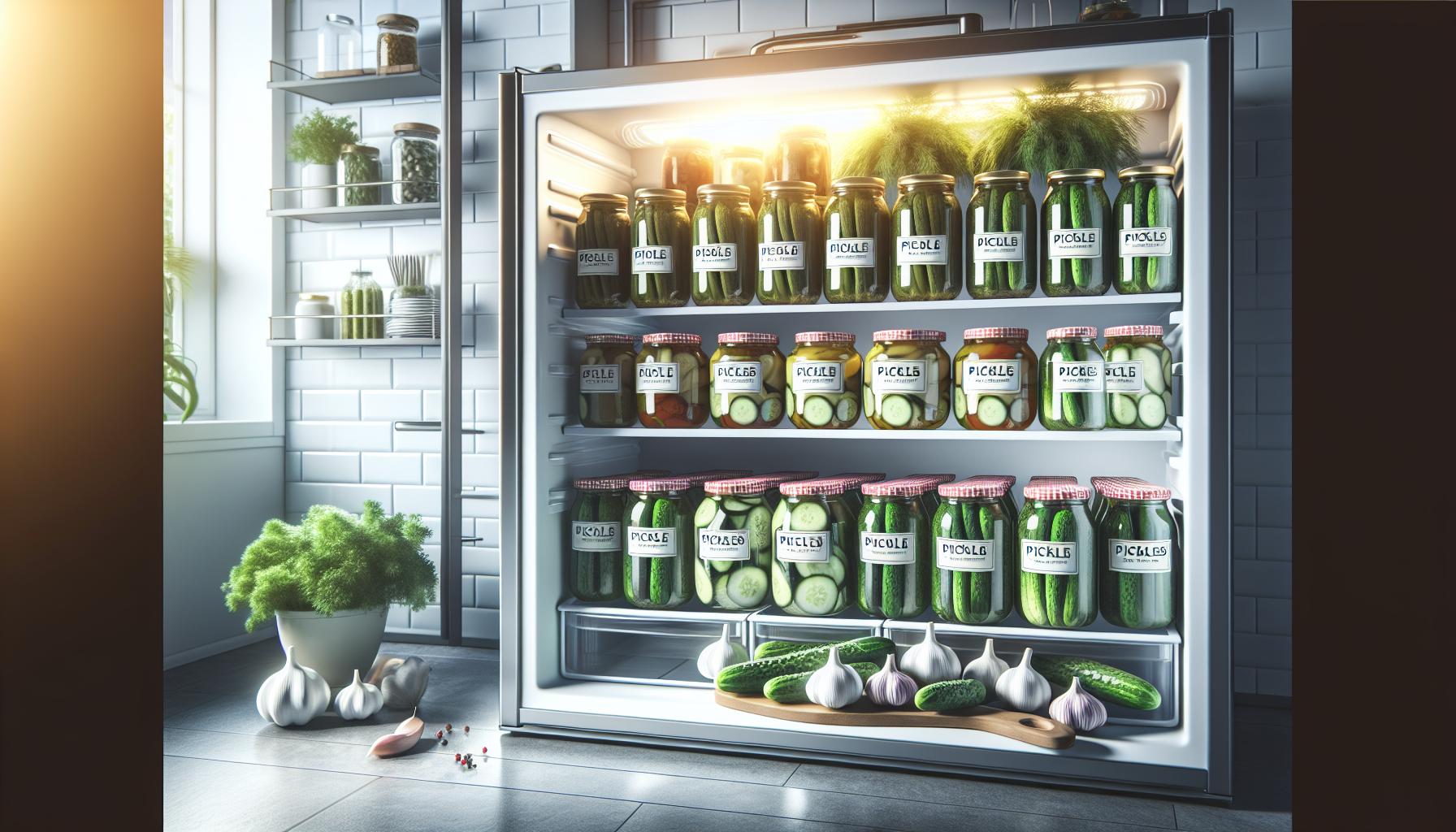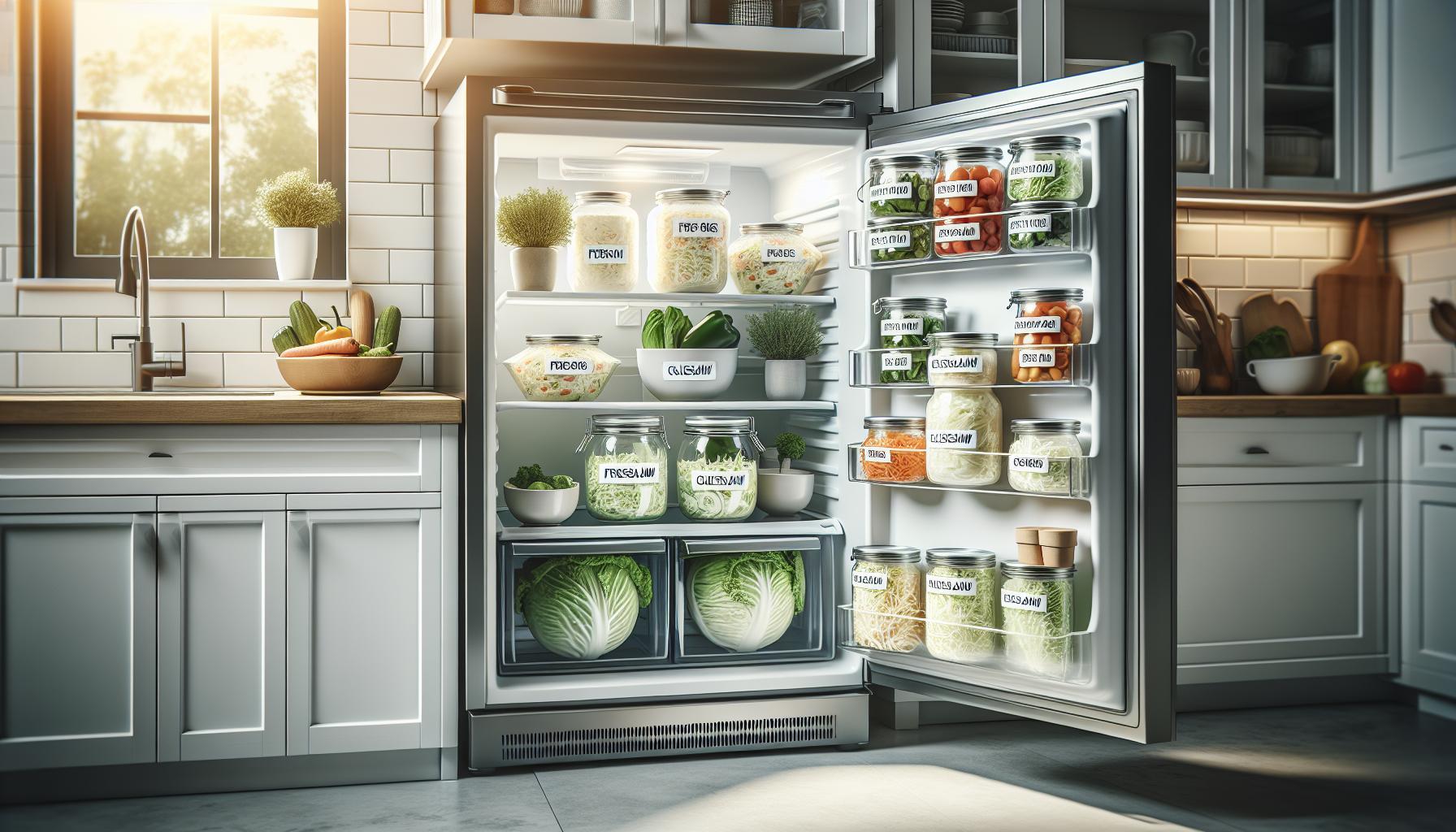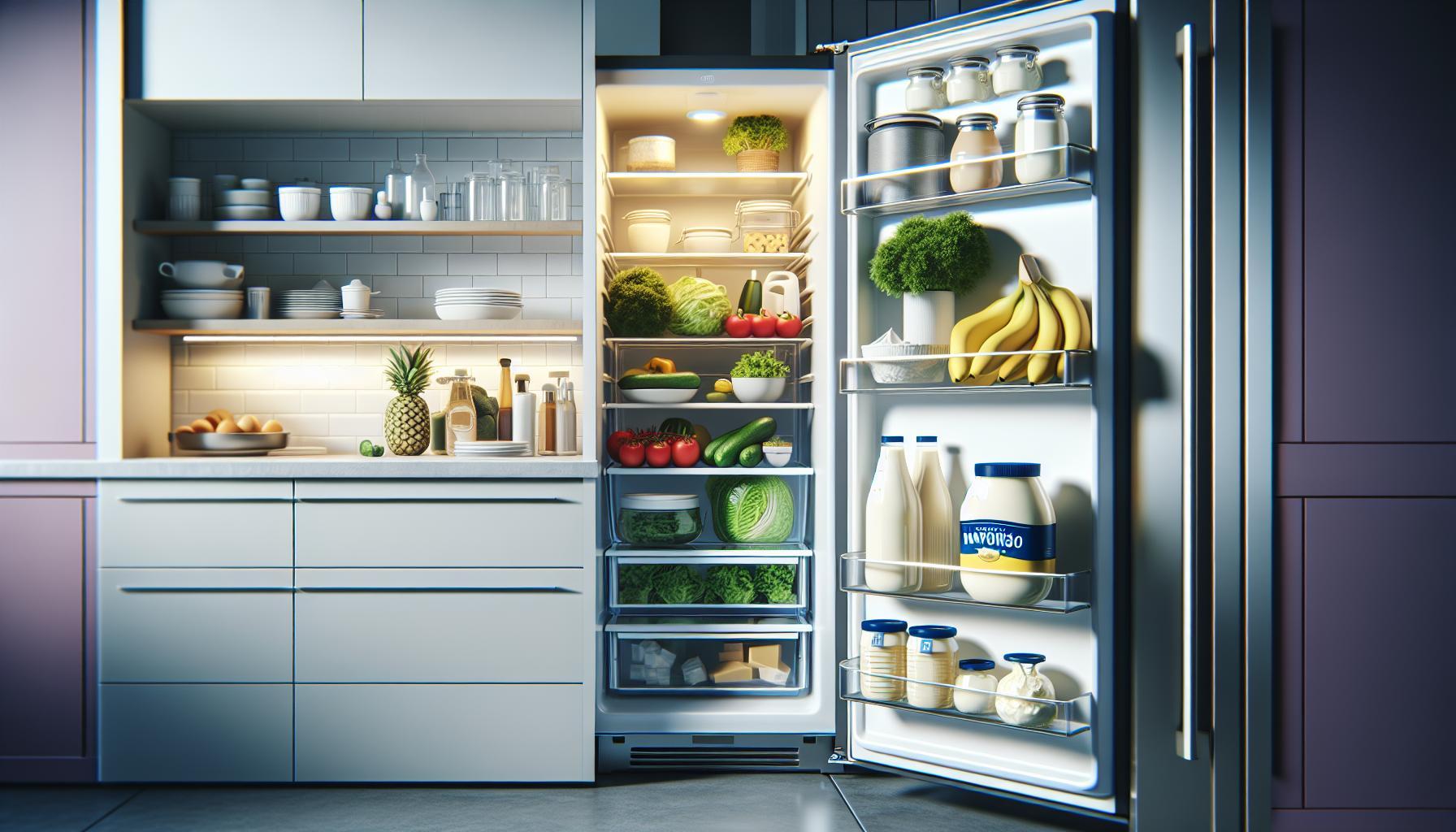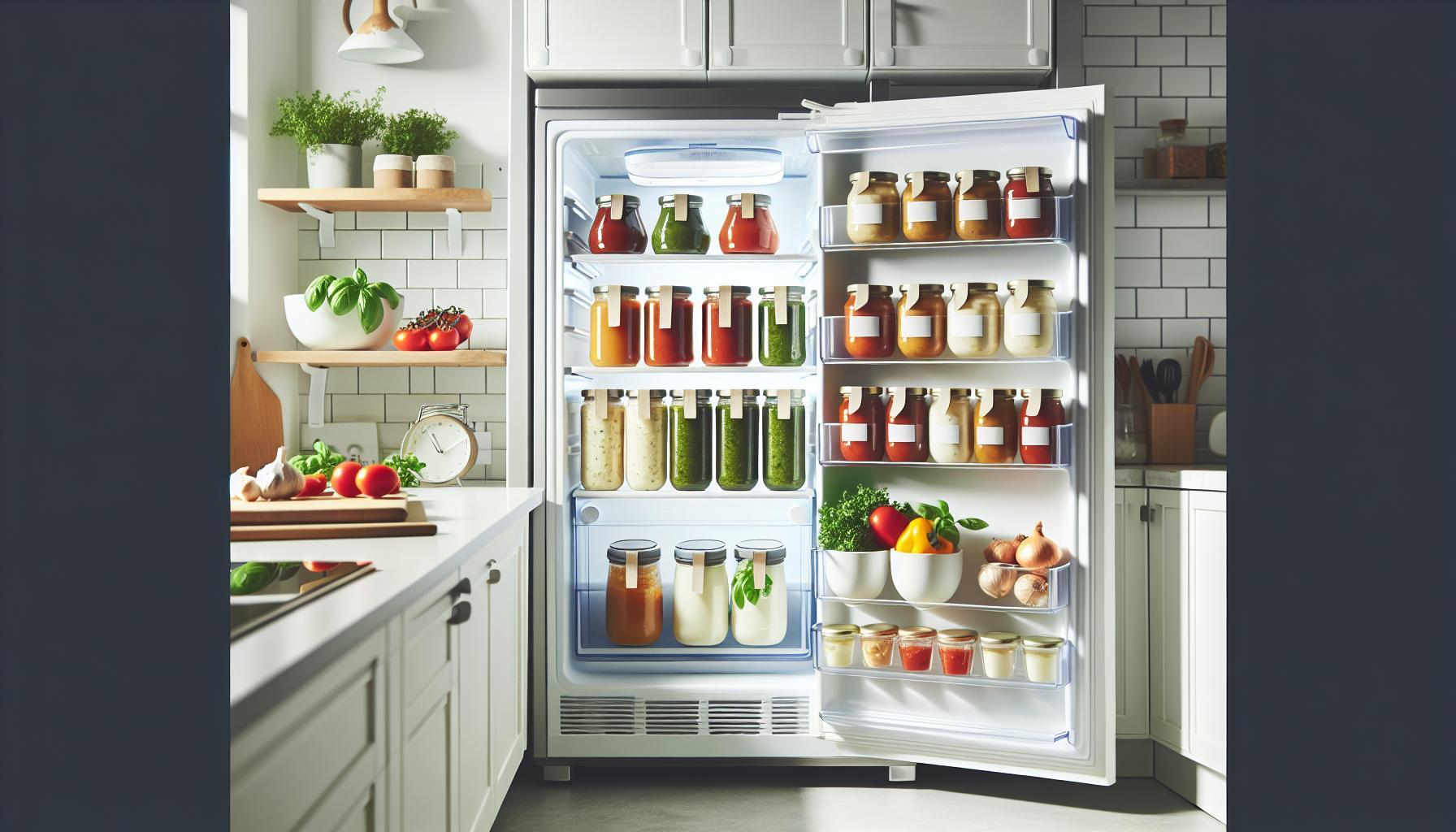Did you know that the crunchiness of your pickles can be preserved for weeks after opening them? Proper storage is crucial to maintain their flavor and texture while ensuring safety. Understanding how long opened pickles last in the fridge not only helps avoid waste but also ensures you enjoy them at their best.
In this guide, we’ll explore the ideal conditions for storing pickles, including temperature guidelines and best practices for sealing jars. You’ll learn the specific timeframes to ensure your pickles remain safe and delicious long after that initial crunch. Dive in to keep your pickles crisp and flavorful, and never wonder about their shelf life again!
How Long Do Pickles Last Once Opened?
Once opened, pickles can last quite a while in your refrigerator, typically anywhere from 1 to 3 months. The exact shelf life largely depends on the type of pickles, their ingredients, and how well they are stored. For instance, commercially produced pickles often contain preservatives and, when kept submerged in their brine, can remain safe to eat for an extended period. Homemade pickles generally have a shorter lifespan, depending on the fermentation process and ingredients used.
To ensure that your pickles stay fresh, it’s crucial to follow proper storage practices. Always keep the lid tightly sealed and store the jar in the refrigerator. The brine plays a significant role in their preservation. If the brine is low, consider adding a bit of vinegar or water to keep the pickles submerged. This not only helps maintain flavor but also reduces the risk of spoilage.
Even with all precautions, it’s important to regularly check your pickles for any signs of spoilage. Discoloration, off-odors, or a fuzzy appearance are clear indicators that your pickles may no longer be safe to eat. Staying vigilant about these signs will help you enjoy your favorite crunchy snacks without worry.
Factors That Affect Pickle Shelf Life

The longevity of pickles once opened is influenced by several key factors, each playing a critical role in their shelf life and overall freshness. Understanding these elements can help you maximize the quality and safety of your pickles, ensuring they remain delicious for as long as possible.
One of the primary factors affecting pickle shelf life is the type of pickle itself. Commercially produced pickles often contain preservatives like calcium chloride, which not only maintains their crunchiness but also extends their edible period. In contrast, homemade pickles, which may rely on natural fermentation processes, generally have a shorter lifespan due to the absence of these artificial additives. Additionally, the ingredients in the brine-such as vinegar concentration, salt, and spices-are crucial; a higher acidity level can lead to longer preservation times.
Storing conditions are another pivotal factor. Temperature and exposure greatly influence how long pickles last after opening. Keeping them consistently refrigerated at or below 40°F (4°C) is essential. Frequent temperature fluctuations, such as leaving the jar out for extended periods or storing it in a door where it’s warmer, can accelerate spoilage. Always be sure the pickles are fully submerged in their brine; if the brine is low, it’s advisable to top it off with additional vinegar or water to prevent air exposure.
Lastly, hygiene, including handling practices, is vital in preserving opened pickles. Each time you dip a utensil into the jar, there is the potential for contamination, which can introduce bacteria or other microorganisms. To mitigate this risk, use clean utensils and ensure the jar is tightly sealed after each use. These practices can significantly affect how long your pickles remain safe and tasty.
By paying attention to these factors-type, storage conditions, and hygiene-you can enjoy your pickles at their best for weeks.
Best Practices for Storing Opened Pickles

To ensure that your opened pickles remain fresh and crunchy, there are several best practices you can follow that emphasize both food safety and maximum enjoyment. Proper storage of pickles directly affects their flavor, texture, and longevity, allowing you to savor them longer while reducing waste.
First and foremost, always keep your opened pickles refrigerated. The ideal temperature for refrigerator storage is at or below 40°F (4°C). Keeping pickles away from the warmer areas of your fridge, such as the door, helps maintain a consistent cold temperature. Make sure that the pickles are fully submerged in their brine. If the brine level is low, top it off with additional vinegar to ensure that the pickles are well-covered. This not only helps maintain their crunchy texture but also reduces the exposure to air, which can accelerate spoilage.
Another critical aspect of storing opened pickles is practicing good hygiene. Contamination from utensils can introduce bacteria to the jar, so always use clean utensils when serving pickles. Avoid using your fingers to pick out a pickle; instead, opt for a clean fork or spoon. After each use, make sure to seal the jar tightly to reduce air exposure. By doing so, you’ll help to prevent the pickles from softening or developing unwanted flavors over time.
Lastly, pay attention to usage timelines. Generally, you can expect opened pickles to last about 1 to 2 months in the refrigerator. While they may still be safe to eat beyond this period if stored correctly, their texture and flavor may begin to deteriorate. Regularly check your pickles for any off smells or changes in appearance, which can indicate spoilage, and consume them while they are still at their best. Following these guidelines will enhance your pickle experience and ensure they provide a satisfying crunch every time.
Signs Your Pickles Have Gone Bad
It’s essential to ensure your pickles remain at their best, both for flavor and safety. Though pickles are preserved in brine, they can still spoil over time after being opened. Recognizing the signs of spoilage will help you avoid any unpleasant surprises.
One of the most apparent indicators that pickles have gone bad is the appearance of mold. If you notice any fuzzy growth on the surface of the brine or on the pickles themselves, it’s best to discard the entire jar. Mold not only affects the quality but poses potential health risks. Additionally, pay attention to changes in the brine color. If the liquid becomes cloudy or tinted, it may signify bacterial growth, suggesting that the pickles should not be consumed.
Another telltale sign of spoiled pickles is an off or sour smell. While pickles naturally have a strong vinegar scent, any unusual or rancid odors may indicate spoilage. Furthermore, if the texture of the pickles has changed from crisp to mushy, they may have started to break down, and eating them could result in an unpleasant experience-not to mention potential digestive issues.
To help you assess the freshness of your opened pickles, here’s a quick checklist to reference:
- Mold on the surface: Discard immediately.
- Cloudy brine: Indicates possible spoilage; consider discarding.
- Off smell: Any rancid or unusual odors suggest it’s best to throw them out.
- Mushy texture: If they no longer have their signature crunch, it’s safer to dispose of them.
By keeping an eye on these signs, you can ensure that your pickles stay safe, tasty, and enjoyable for as long as possible.
How to Keep Pickles Crunchy and Fresh
To ensure your pickles maintain their delightful crunch, follow these effective storage strategies and practices. One of the keys to preserving the crispness of pickles begins with their storage temperature. Keep opened jars in the refrigerator right after use, as consistent cold temperatures slow down spoilage and help keep the texture intact.
Another vital factor is ensuring that pickles are always submerged in their brine. This not only protects them from exposure to air but also helps maintain their crispness. If you notice that the brine level is low, feel free to top it off with a mixture of vinegar and water, adjusting the ratio based on how tangy you want your pickles. Alongside this, avoid cross-contamination by using clean utensils when removing pickles from the jar. This practice can prevent unwanted bacteria from introducing spoilage or affecting their texture.
To keep your pickles extra crunchy, consider adding a few grape leaves or a small piece of horseradish to the jar. These natural ingredients contain tannins, which can help maintain firmness. If you’re still worried about maintaining their texture, consume them within two months of opening, as this is typically the recommended timeframe for peak freshness.
Storing pickles properly not only preserves their beloved crunch but also ensures they remain safe and enjoyable. By following these simple yet effective techniques, you can enjoy your pickles to the fullest!
Freezing Pickles: Is It Possible?
While freezing pickles might seem like an innovative solution for preserving your favorite jars, it’s important to understand that the outcome may not meet your expectations. The crisp texture that defines delicious pickles can suffer significantly from freezing temperatures. When pickles are frozen, the water within them expands, which can lead to a mushy texture once they’re thawed. Hence, while technically possible, freezing is generally not recommended for maintaining the quality of your pickles.
If you still wish to proceed with freezing pickles, consider slicing them into smaller pieces and placing them in airtight freezer bags or containers. Remove as much air as possible to prevent freezer burn. However, be prepared for the texture to change; thawed pickles are best used in recipes where crunchiness isn’t as critical, such as in relishes, salads, or blended sauces.
Alternative Storage Methods
Instead of freezing, it may be more beneficial to focus on other preservation methods that support both flavor and texture.
- Canning: If you want to store pickles for an extended period, proper canning can keep them safe and delicious for up to a year.
- Refrigeration: As previously mentioned, keeping opened jars in the fridge and ensuring they are submerged in their brine can help maintain their quality for up to two months after opening.
Emphasizing these alternative strategies will not only help preserve the beloved crunchiness of pickles but also ensure their delightful flavor remains intact, offering your culinary creations the best possible taste and texture.
Homemade vs. Store-Bought Pickle Lifespan
While the debate between homemade and store-bought pickles often hinges on flavor and freshness, the lifespan of these two options once opened presents its own unique considerations. Homemade pickles, crafted with controlled ingredients and methods, typically offer a shorter shelf life compared to commercial varieties. This is largely due to the absence of preservatives found in many store-bought products. Generally, opened homemade pickles can maintain their quality for about 1 to 2 months when stored in the refrigerator, especially if kept submerged in their brine.
In contrast, store-bought pickles tend to last longer due to the preservatives and additives that help inhibit spoilage. After opening, they can last up to 3 months in the fridge, as long as they are stored correctly. This extended shelf life is beneficial for those who might not consume pickles as quickly, allowing for more flexibility in meal planning and snacking. However, both varieties require attention to storage conditions: keeping them tightly sealed in their original brine and refrigerated is essential for prolonging their freshness and crunchiness.
It’s also important to note that individual preferences and ingredient variations can affect the longevity of either type. Homemade pickles with garlic or additional spices may develop stronger flavors over time and could spoil faster, while those made with vinegar-based brines are likely to last longer. When choosing between homemade and store-bought, consider not just shelf life but also your consumption habits, ensuring that whichever type you select fits your lifestyle while delivering the delightful crunch you crave.
Understanding the Science of Pickle Preservation
The preservation of pickles, a process that blends art and science, relies heavily on the principles of fermentation and brining. When cucumbers are submerged in a saltwater solution or vinegar, the environment becomes inhospitable for spoilage-causing bacteria while encouraging beneficial microorganisms to thrive. These beneficial bacteria create lactic acid, which not only imparts that distinct tangy flavor we love but also acts as a natural preservative, extending the shelf life of pickles.
Understanding the pH level is crucial in pickle preservation. Most pickles are made in a vinegar-based brine that achieves a pH of 4.6 or lower, a threshold that inhibits the growth of pathogens such as Clostridium botulinum, which can cause botulism. When you open a jar of pickles, maintaining that acidic environment is essential. This is why it is recommended to always store opened pickles in the refrigerator, ensuring they remain submerged in their brine to retain their crunchy texture and safety.
In addition to pH levels, the presence of preservatives in store-bought pickles, like calcium chloride, helps maintain crunchiness and prevent spoilage. Homemade pickles, while often more flavorful due to customized spices and ingredients, generally lack these commercial preservatives. Therefore, it’s vital to consume them within 1 to 2 months after opening, while store-bought varieties can last up to 3 months under the same conditions. Ultimately, understanding these scientific layers behind pickle preservation can empower you to store and enjoy your pickles safely, enhancing both their longevity and your culinary experience.
Creative Ways to Use Leftover Pickles
Using leftover pickles can elevate your dishes in delightful and unexpected ways, ensuring none of that tangy goodness goes to waste. Pickles are versatile and can serve as more than just a crunchy side; they can be incorporated into a variety of recipes that enhance their flavors and textures.
One great way to utilize those leftover pickles is by finely chopping them to create a zesty relish. This relish can be added to sandwiches, burgers, or hot dogs, offering a satisfying crunch and a burst of flavor. You can also mix it into sauces or dressings, adding it to tuna salad or potato salad for an interesting twist. The acidity of the pickles complements these dishes beautifully, brightening up hearty ingredients.
Another creative approach is to blend pickles into a creamy dip. Combine chopped pickles with cream cheese, sour cream, or Greek yogurt, and mix in some herbs and seasonings. This dip is perfect for chips, crackers, or fresh vegetables, making for a refreshing appetizer or snack. Additionally, using sliced pickles as a topping for gourmet grilled cheese sandwiches or pizzas introduces a distinctive flavor profile that contrasts deliciously with cheese and other toppings.
To further extend the life of your pickles, consider pickling other vegetables in the leftover brine. Carrots, garlic, or radishes can soak up the brine’s flavor and create unique, quick-pickled additions for salads, rice bowls, or as garnishes. This not only adds variety to your meals but also keeps waste to a minimum while maintaining the pickle’s delightful tang.
Lastly, don’t forget about using leftover pickle juice! It can be a fantastic ingredient for marinades, giving meats and tofu an extra punch of flavor. Some people even swear by its benefits as a hangover remedy! Whichever method you choose, incorporating leftover pickles into your meals is a great strategy for adding excitement and reducing waste in the kitchen.
Common Mistakes in Pickle Storage
Storing pickles properly is essential to maintaining their crunchiness and extending their shelf life, yet many people unknowingly make common mistakes that can lead to spoilage or loss of texture. One prevalent error is failing to ensure that pickles remain submerged in their brine. Exposure to air can lead to oxidation and spoilage; therefore, always check that the pickles are fully covered in the pickling liquid. If there’s not enough brine, consider adding a little vinegar or making additional brine to refill the jar.
Another mistake involves improper sealing of pickle containers. Pickles should ideally be kept in airtight glass jars or containers. If the lid is left loose or if they are stored in containers that are not airtight, the pickles can become soggy or may develop unwanted flavors due to air exposure. After each use, ensure that the lid is tightly closed to reduce the risk of contamination and preserve the quality for a longer period.
Temperature fluctuation can also affect the quality of your pickles. It’s important to store opened pickles in the refrigerator consistently, as the ideal temperature is between 34°F and 40°F (1°C to 4°C). Opening the fridge frequently or storing them in the door, where temperatures are less stable, can negatively impact their preservation. Instead, place your pickles toward the back of the fridge, away from the door, to keep them at a more consistent temperature.
Lastly, using contaminated utensils or hands can introduce bacteria to the brine, leading to quicker spoilage. Always use clean utensils when retrieving pickles from the jar, and avoid using your fingers. By adhering to these storage guidelines and avoiding these common pitfalls, you can enjoy your pickles at their best for weeks or even months after opening.
Exploring Different Types of Pickles and Their Freshness
Different types of pickles offer a variety of flavors and textures, making them a delightful addition to many meals. However, their longevity and freshness can differ based on how they are processed and stored. Understanding these distinctions is essential for maximizing their shelf life and keeping them crunchy once opened.
Cucumbers are most commonly pickled, but peppers, carrots, and even fruits can also be transformed into pickles. Fermented pickles, such as kosher dill or bread-and-butter varieties, often have a more complex flavor profile due to the fermentation process. When stored properly in the fridge, these pickles can remain fresh for about 1 to 2 months after opening. On the other hand, vinegar-based pickles-like quick pickles or commercially canned varieties-tend to have a longer shelf life, often lasting up to 3 months post-opening due to their lower pH, which inhibits bacterial growth.
The freshness of pickles can also be affected by their packaging. For instance, pickles from glass jars typically have a longer shelf life compared to those in plastic containers. This is due to glass being impermeable, keeping air out better than plastic, which can lead to quicker spoilage. Furthermore, whether the pickles contain preservatives can also make a significant difference. Store-bought varieties often include preservatives that can extend their freshness, whereas homemade pickles made without preservatives should be consumed more quickly, typically within a couple of weeks.
To ensure you enjoy your pickles at their best, it’s essential to note that regardless of type, they should always be kept submerged in their brine, stored in airtight containers, and consistently refrigerated. These practices not only help maintain their crunchiness but also minimize the risk of spoilage. By understanding the nuances between different types of pickles and how to store them properly, you can ensure a delicious and safe culinary experience.
Q&A
Q: How long do pickles last after opening in the fridge?
A: Once opened, pickles typically last for 1 to 3 months in the refrigerator. For optimal freshness, always ensure the pickles are submerged in their brine and tightly sealed.
Q: Can you eat pickles after the expiration date?
A: Yes, pickles can often be consumed after the expiration date if they have been stored properly in the refrigerator and show no signs of spoilage. However, always check for changes in texture, smell, or appearance.
Q: How can I tell if pickles have gone bad?
A: Signs that pickles have gone bad include a foul odor, mold growth, or a mushy texture. If you notice any of these signs, it’s best to discard them immediately for safety.
Q: Why are my pickles losing their crunchiness?
A: Pickles may lose their crunchiness due to improper storage or exposure to air. To keep them crunchy, ensure they remain submerged in their brine and are stored in a tightly sealed jar.
Q: Can I keep pickles in the pantry once opened?
A: No, opened pickles should be refrigerated to prevent spoilage. Storing them in the pantry after opening can lead to bacterial growth and spoilage.
Q: What is the best way to store pickles for maximum freshness?
A: Store opened pickles in their original brine in a glass jar with a secure lid in the refrigerator. Avoid introducing air by using clean utensils and keep them submerged in the brine.
Q: How can I preserve the flavor of pickles after opening?
A: To preserve flavor, always reseal the jar tightly after use and ensure the pickles remain in their brine. Avoid leaving the jar open for extended periods.
Q: Can you freeze pickles to extend their shelf life?
A: Freezing pickles is possible but may alter their texture. If you choose to freeze them, place them in airtight containers, but consume them within 6 months for the best quality.
These FAQs provide practical, science-based answers for pickle storage and longevity while encouraging readers to explore related articles for more information on food preservation and safety.
In Summary
Now that you’re equipped with the knowledge of how long pickles last in the fridge once opened, remember that proper storage is key to maintaining their crunch and flavor. Storing them in an airtight container and keeping them submerged in the brine will help maximize their shelf life. Don’t let your pickles go to waste-check them regularly and enjoy them within 1 to 3 months for the best taste and texture!
If you found this information helpful, dive deeper into our related articles on homemade pickle recipes or explore tips for preserving more of your favorite vegetables. For even more food safety tips and storage hacks, consider subscribing to our newsletter for the latest updates and exclusive content. Your pickles deserve the best care; let us guide you on how to keep all your favorite foods fresh longer! Feel free to share your own pickling stories or ask any questions in the comments below; we love hearing from you!





